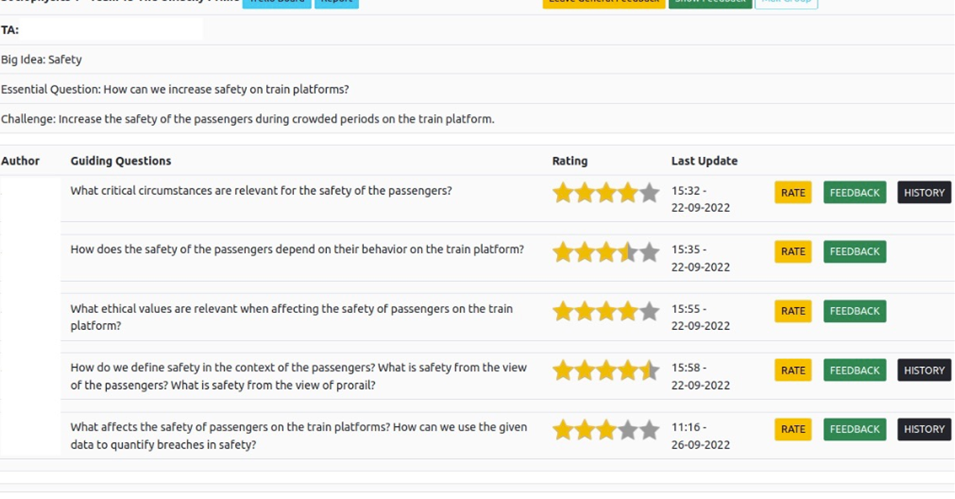Insights from the Physics of Social Systems courses and the use of Living Labs and a CBL dashboard.
Interview with Federico Toschi, head teacher Applied Physics and Science Education for the USE Learning Line Physics of Social Systems and the bachelor course Sociophysics 1 and 3 (3QEUS0 and 3QAUS0) for 90 students, and Antal Haans, responsible teacher for the course Sociophysics 2 (3QSUS0).
Sociophysics is a field of science that uses mathematical tools inspired by physics to understand the behavior of human crowds. This project took the data on crowd dynamics in a train station as its starting point. The CBL project was open-ended, multidisciplinary, with a real external stakeholder providing the data. The course was divided into the following 3 courses.
The courses used TU/e's Living Labs and the teachers developed a reusable dashboard to allow teachers to measure student progress.
Q: Can you explain how you used TU/e Living Labs?
Federico: “So we received real data from ProRail, our stakeholder. Inspired by this data, the students were able to create models and carry out experiments in the Market Hall Living Lab to test hypothesis. They simulated the railway platform and tested different nudges on crowd behavior. Having such a real place for experiments makes the course very tangible.”
Q: This course is very open ended. Can you tell us a bit about your journey before coming here?
Federico: “In year 2020/21 we started with a cap of 36 students (9 groups) and 3 teaching assistants (each supervising 3 groups each). Students defined and implemented their own challenge and project.
When we wanted to scale up, we identified issues that hindered this. The 3 main problems were:
- Students were not familiar with CBL and were not able to define proper guiding questions (GQs), guiding activities (GAs) and guiding resources (GRs). Students felt really uncomfortable not knowing when their effort was good enough.
- Group work was not efficient enough. They did not appreciate the SCRUM methodology and felt the urge to deliver results instead of using the process to create better results.
- Feedback from lecturers and TAs was often not effectively received by students, leading to significant delays in the project work. Even when we provided short feedback loops, they were still going very slow.”
Q: How did you deal with the problems?
Federico: “We could have made it less open ended. But our goal wasn’t to teach students a specific physics topic. Instead, we wanted to enable them to become physicists by inventing descriptions and models for unexplored phenomena. This multidisciplinary context also included psychology and ethics.
Antal: “We tried to find ways to support the students’ learning process. Not to tell them exactly what to do, but to guide them in finding their answers.
- We created or improved educational materials for students. We created a CBL bootcamp, provided teaching materials on CBL and SCRUM and guidelines for team formation. And we developed assessment and feedback formats.
- We also offered our TAs better training on CBL, SCRUM and group dynamics and gave them guidelines and rubrics to support their assessments.
- We created a dashboard to track progress. Here’s an example of the dashboard. It shows what guiding questions the students have submitted, the teacher’s assessment of them and the teacher’s feedback. We also used this dashboard to track and visualize the marks and assessments given by their TAs on their performance in scrumming.”

Q: How has the dashboard helped you to scale up your course?
Federico: “We can see very quickly if one group of students is underperforming compared to others, so we can intervene immediately.
It also makes it easier to give quick feedback to our students, and for us teachers to divide up who gives feedback to which group of students”.
Q: Can other teachers at TU/e use it too?
Federico: “Absolutely, it is a flexible tool and you can change a lot of settings. We are in the process of trying to get this adopted as an “official” tool at the university. In the meantime, colleagues can contact me if they want to use it or just to know more”.
Q: What lessons learned would you like to pass on to your colleagues?
Federico: “Teaching CBL has really changed my attitude to learning. We went from asking, "What do I want to teach?" to, "How can I help students learn?" and really thinking about how to give the right resources to students.
This shift really gave me a new and deeper vision on learning.
When you start to design real-life challenges, I advise other teachers to use natural settings. Then students can relate to it, which motivates them more. I am not saying that it is easy to find these topics. It is a big jump out of your comfort zone, but it is worth it.
Working with real life challenges and external stakeholders has also had a positive impact on my own research. We got the data from our stakeholder, ProRail, and the educational activities could act in synergy with research done by post-docs, PhDs and researchers on this same topic.”
Antal: “Same goes for me. We obtained funding to hire a post-doc to actual do the research our students were doing. This has been beneficial in supervising and coaching the student teams, beside of course allowing us to put what we learned from the students in to practice ourselves and make this knowledge available through publications.”
Q: Finally, what advice would you give to colleagues who are about to start with CBL?
Federico: “First I would recommend investing in getting a new CBL mindset: look at current CBL courses, maybe even outside your department. Get examples, get inspired.
Antal: “The advantage of CBL is that students gain knowledge and apply it immediately. Be careful about using CBL to teach mainly theory. You would need to be very skilled, and actually it is still possible and possibly better to teach knowledge in the older and more traditional ways. So, check the intended learning outcomes of your course first.”
About TU/e Living Labs
Living Labs are open innovation ecosystems in real-world environments that use iterative feedback processes throughout an innovation’s lifecycle to create sustainable impact. TU/e currently hosts five Living Labs, each with its own infrastructure and experts involved: Atlas, Market Hall, Matrix, Campus Site and the Workplace Vitality Hub. The Living Labs have sensors, data, and other infrastructure that allow teachers and students to focus more on conducting experiments and less on logistical details. This helps streamline students' experiments and maximize their learning. Visit the Living Labs page for more information.
More information
- For more details about the course, see the case description of Sociophysics 3 (3QAUS0). Here you can find a short description of the set-up and the materials used.
- To access the dashboard, to find out if it is useful for your course, please contact Federico directly.

